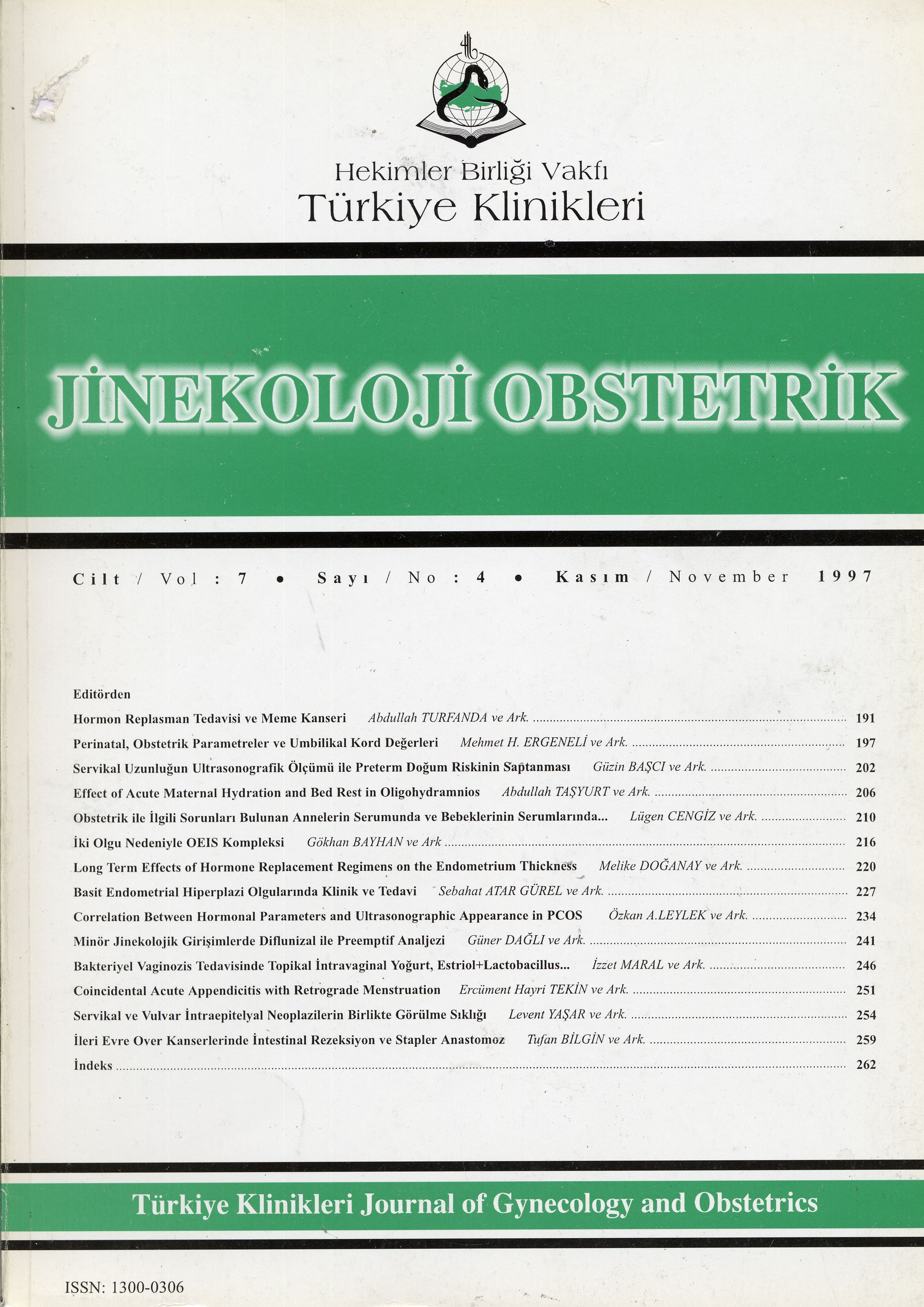Open Access
Peer Reviewed
ARTICLES
2699 Viewed1082 Downloaded
Farklı Hormon Replasman Tedavi Rejimlerinin Endometrial Kalınlık Üzerine Uzun Süreli Etkisi
Farklı Hormon Replasman Tedavi Rejimlerinin Endometrial Kalınlık Üzerine Uzun Süreli Etkisi
Turkiye Klinikleri J Gynecol Obst. 1997;7(4):220-6
Article Language: TR
Copyright Ⓒ 2025 by Türkiye Klinikleri. This is an open access article under the CC BY-NC-ND license (http://creativecommons.org/licenses/by-nc-nd/4.0/)
ÖZET
Amaç: Naturel menopozda farklı hormon replasman tedavilerinin endometrial kalınlık üzerine etkilerini belirlemek. Çalışmanın Yapıldığı Yer: Dr. Zekai Tahir Burak Kadın Hastanesi Menopoz Bölümü. Materyal ve Metod: Bu çalışma 1991-1996 yılları arasında yaşları 45-65 arasında değişen 2800 hasta üzerinde yapılmıştır. Hastalar 10 farklı gruba ayrılmıştır. İlk gruba devamlı CEE+MPA, ikinci gruba siklik CEE+MPA, üçüncü gruba devamlı transdermal 17b-estradiol+MPA, dördüncü gruba siklik transdermal 17b-estradiol+MPA, beşinci gruba devamlı CEE+Didrogesteron, altıncı gruba siklik CEE+ Didrogesteron, yedinci gruba devamlı transdermal 17b-estradiol+Didrogesteron, sekizinci gruba siklik transdermal 17b-estradiol+Didrogesteron, dokuzuncu gruba Tibolon, onuncu gruba Estradiol Valerat+Siproteron Asetat verildi. Tedavi öncesi bütün gruplara vaginal ultrasonografi ile bakıldı. Endometrial kalınlık 4mm üzerinde olanlardan biyopsi alındı. Tedavinin 1.,2.,3.,4. ve 5. yıllarında hastaların endomet-rial kalınlığı ölçüldü ve gereğinde biyopsileri tekrarlandı. On grup arasında yıldan yıla olan değişimler ''tek yönlü varyans analizi'' ile, gruplar arasında yıllara göre değişimler örneklere bağlı ''iki yönlü varyans analizi'' ile ; her grup arasındaki değişimler ''Paired t Test ve Kappa Kat Sayısı'' kullanılarak değerlendirildi. Sonuçlar: Gruplar karşılaştırıldığında her bir grup arasında istatistiksel olarak anlamlı bir fark gözlenmedi (p>0.05). Ortalama endometrial kalınlık 2.9 mm olarak belirlendi. Histopatolojik olarak % 53.4 atrofik, %32.8 proliferatif, %13.2 oranında disosiye glandlar tespit edildi.Tartışma: Bu çalışma, naturel menopozda uygulanan hormon replasman tedavilerinin endometriyumu en iyi koruyanının seçimine yeni bir bakış açısı kazandıracaktır.
ANAHTAR KELİMELER: Menopause, Hormon replacement therapy, Endometrial thickness
ABSTRACT
Objective: To determine the effect of different hormone replacement therapy on the endometrial thickness in natural menopause. Instıtution: The Department of Menopause of Dr. Zekai Tahir Burak Hospital. Materials and Methods: The research was undertaken between 1991 and 1996 on 2800 women, whose ages ranged between 45-65 and who were under natural menopause. These patients were divided into ten groups who received different treatments. The first group was given CEE + MPA (continous) ; the second group: CEE+ MPA (Cyclic); the third group: transdermal 17b -oestradiol+MPA (continuous); the fourth group: transdermal 17b -oestradiol+MPA (Cyclic); fifth group: CEE +Didrogesteron (Continous); the sixth group: CEE+Didrogesteron (Cyclic); the seventh group: transdermal 17b -oestradiol +Didrogesteron (Continous); the eighth group: transdermal 17b -oestradiol + Didrogesteron (Cyclic); the ninth group: tibolon; the tenth group Estradiol valerate+Ciproteron Acetate. Before the treatment, all groups were examined by vaginal ultrasonography and biopsy was taken if their endometrial thickness was over 4 mm. During the 1 st, 2 nd, 3rd, 4 th, and 5th years of their treatment, the patients' endometrial thickness was measured and endometrial biopsy was repeated if necessary. Variations in ten groups according to year by year carried out by ''One Way Variance Analysis''; the trends according to years in the ten groups was carried out by ''Two Way Variance Analysis of Dependent Samples''; the variations in every group one by one was done by using the ''Paired t Test and calculating the Kappa Coefficient figures''. Results: When we compare groups and with respect to treatment periods there was no statistical significance between each of them (p>0.05). The mean of endometrial thickness was found 2.9 mm. Atrophic changes were observed as a rate of 53.4%. The rate of proliferative changes was 32.8% and the rate of dissosiative glands changes was found to be 13.2%. Conclusion: This study will provide a new outlook in choosing the best treatment for protecting the endometrium during hormone replacement therapy in natural menopause.
Objective: To determine the effect of different hormone replacement therapy on the endometrial thickness in natural menopause. Instıtution: The Department of Menopause of Dr. Zekai Tahir Burak Hospital. Materials and Methods: The research was undertaken between 1991 and 1996 on 2800 women, whose ages ranged between 45-65 and who were under natural menopause. These patients were divided into ten groups who received different treatments. The first group was given CEE + MPA (continous) ; the second group: CEE+ MPA (Cyclic); the third group: transdermal 17b -oestradiol+MPA (continuous); the fourth group: transdermal 17b -oestradiol+MPA (Cyclic); fifth group: CEE +Didrogesteron (Continous); the sixth group: CEE+Didrogesteron (Cyclic); the seventh group: transdermal 17b -oestradiol +Didrogesteron (Continous); the eighth group: transdermal 17b -oestradiol + Didrogesteron (Cyclic); the ninth group: tibolon; the tenth group Estradiol valerate+Ciproteron Acetate. Before the treatment, all groups were examined by vaginal ultrasonography and biopsy was taken if their endometrial thickness was over 4 mm. During the 1 st, 2 nd, 3rd, 4 th, and 5th years of their treatment, the patients' endometrial thickness was measured and endometrial biopsy was repeated if necessary. Variations in ten groups according to year by year carried out by ''One Way Variance Analysis''; the trends according to years in the ten groups was carried out by ''Two Way Variance Analysis of Dependent Samples''; the variations in every group one by one was done by using the ''Paired t Test and calculating the Kappa Coefficient figures''. Results: When we compare groups and with respect to treatment periods there was no statistical significance between each of them (p>0.05). The mean of endometrial thickness was found 2.9 mm. Atrophic changes were observed as a rate of 53.4%. The rate of proliferative changes was 32.8% and the rate of dissosiative glands changes was found to be 13.2%. Conclusion: This study will provide a new outlook in choosing the best treatment for protecting the endometrium during hormone replacement therapy in natural menopause.
MENU
POPULAR ARTICLES
MOST DOWNLOADED ARTICLES





This journal is licensed under a Creative Commons Attribution-NonCommercial-NoDerivatives 4.0 International License.










